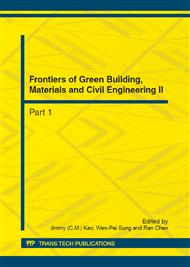p.1365
p.1371
p.1376
p.1380
p.1384
p.1389
p.1393
p.1397
p.1401
Experimental Study of the Tensile Bond Strength in Concrete Aggregate - Paste Interfacial Transition Zone
Abstract:
Study on the characteristics of tensile bond strength in concrete interfacial transition zone. Calculate the tensile bond strength of interfacial transition zone in concrete by the way of vertical drawing cobblestones of different grain size from C30 concrete by MTS hydraulic loading system .(the grain size include 50,70,90,100mm) results show that:1.when the cobblestones diameter is in a certain range(<90mm in this experiment)or the bonded area is in a certain range(<5251 mm2 in this experiment), The tensile bond strength of concrete interfacial transition zone nothing to do with the cobblestones diameter and the bonding area.2.If the cobblestones diameter or the bonded area is too large, it will affect the bonding effect of the cobblestones and concrete, and cause the depression of tensile bond strength, Therefore , In the actual engineering we should avoid the use of large diameter cobblestones .3. The tensile bond strength of C30concrete interfacial transition zone is approximately 4% - 10% of compressive strength of concrete.
Info:
Periodical:
Pages:
1384-1388
Citation:
Online since:
August 2012
Authors:
Price:
Сopyright:
© 2012 Trans Tech Publications Ltd. All Rights Reserved
Share:
Citation:


